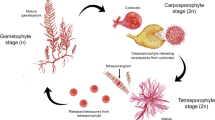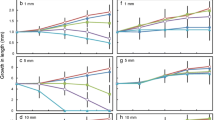Abstract
Cultivations of the brown seaweed, Saccharina japonica, was developed, promoted, and industrialized in the 1970s and is highly valued in Korea both for human consumption and as a feed for the rapidly developing abalone farming industry. Production has continually increased, and approximately 442,637 tonnes wet weight was harvested in Korea in 2015. Abalone is a highly sought-after delicacy in Korea, and the abalone farming industry has been developed based on a stable production of seaweed. Korean abalone farmers prefer to feed their stock on locally cultured S. japonica; however, between August and November, the supply of farmed S. japonica declines because higher seawater temperatures reduce S. japonica productivity. In an attempt to overcome this temperature-induced period of low production, cultivation trials with a strain of S. japonica selected to withstand higher cultivation temperatures were undertaken. Strain selection involved using individual parent thalli that were found to remain productive under high seawater temperature (26 °C) at Wando. Male and female gametophytes were isolated through 3 cycles of free-living gametophyte culture to produce the F3 strain used in the production trials. Production trials using the selected strain were initiated every month between December 2014 and March 2015. This delayed the initiation of culture beyond the latest initiation time currently used by farmers (December). Delaying initiation of cultivation resulted in delayed maximum growth compared to the control. Growth of the F3 strain continued for up to 3 months longer than normally achieved on farms for non-selected thalli. The mean length, growth rate, and biomass were also greater than those achieved by the control strain. The use of the F3 strain of S. japonica coupled with delayed initiation of culture can therefore be used to help to ensure a stable year round algal feed supply for abalone industry in Korea.





Similar content being viewed by others
References
Dring MJ (1982) The biology of marine plants. Edward Arnold Publishers, London 199 pp
Fang TC, Wu CY, Jiang BY, Li JJ, Ren GZ (1962) The breeding of a new breed of Haidai (Laminaria japonica Aresch.) and its preliminary genetic analysis. Acta Bot Sinica 10(3):197–209
Gerard VA, Du Bois KR (1988) Temperature ecotypes near the southern boundary of the kelp Laminaria saccharina. Mar Biol 97:575–580
Gong YG (1991) Growth and morphological variation of cultured and natural Laminaria japonica Areschoug. MSc thesis. Pukyong National University, Busan 35 pp
Hwang EK, Baek JM, Park CS (2009) The mass cultivation of Ecklonia stolonifera Okamura as a summer feed for the abalone industry in Korea. J Appl Phycol 21:585–590
Hwang EK, Gong YG, Park CS (2011) Cultivation of a brown alga, Undariopsis peterseniana (Kjellman) Miyabe et Okamura as a warm temperature species by artificial seed production in Korea. J Appl Phycol 23:449–455
Hwang EK, Hwang IK, Park EJ, Gong YG, Park CS (2014) Development and cultivation of F2 hybrid between Undariopsis peterseniana and Undaria pinnatifida for abalone feed and commercial mariculture in Korea. J Appl Phycol 26:747–752
Innes DJ (1988) Genetic differentiation in the intertidal zone in populations of the alga Enteromorpha linza (Ulvales; Chlorophyta). Mar Biol 97:9–16
Jang JW, Gweon SH (1970) Studies on Laminaria cultivation. Report of the National Fisheries Research and Development Agency 5:63–74
Kang JW (1966) On the geographical distribution of marine algae in Korea. Bull Pusan Fish Coll 7:1–125
Kim HG, Park JG, Kim DS (2005) Comparative laboratory culture studies of the native kelp, Kjellmaniella crassifolia and the introduced kelp Laminaria japonica in east coast of Korea. J Aquacult 18:299–304
KOSIS (2017) Korean statistical information service. http://kosis.kr. Cited 05 Jan 2017
Levitt J (1972) Responses of plants to environmental stresses. Academic Press, New York 687 pp
Lewis JL, Neushul M, Harger BWW (1986) Interspecific hybridization of the species of Macrocystis in California. Aquaculture 57:203–210
Liu F, Yao J, Wang X, Repnikova A, Galanin DA, Duan D (2012) Genetic diversity and structure within and between wild and cultivated Saccharina japonica (Laminariales, Phaeophyta) revealed by SSR markers. Aquaculture 358-359:139–145
Liu F, Sun X, Wang F, Wang W, Liang Z, Lin Z, Dong Z (2014) Breeding, economic traits evaluation, and commercial cultivation of a new Saccharina variety “Huangguan no.1”. Aquacult Int 22:1665–1675
Lobban CS, Harrison PJ, Duncan MJ (1985) The physiological ecology of seaweeds. Cambridge University Press, Cambridge 242 pp
Lüning K (1980) Critical levels of light and temperature regulating the gametogenesis of three Laminaria species (Phaeophyceae). J Phycol 16:1–15
MOF (2016) Statistical data of the Ministry of Oceans and Fisheries. http://www.fips.go.kr. Cited 05 Jan 2017
Park CS, Hwang EK (2012) Seasonality of epiphytic development of the hydroid Obelia geniculata on cultivated Saccharina japonica (Laminariaceae, Phaeophyta) in Korea. J Appl Phycol 24:433–439
Parker RE (1979) Introductory statistics for biology, 2nd edn. Edward Arnold, London
Sohn CH (1998) The seaweed resources of Korea. In: Critchley AT, Masao O (eds) Seaweed resources of the world. Japan International Cooperation Agency, Yokosuka, Japan, pp 15–33
Son MH, Park MW, Kim BH, Lee SW (2014) A study on the comparative analysis of business performance of abalone seed, Haliotis discus hannai by region and farming size in the land-based system. J Fish Business Admin 46:1–13
Tatewaki M (1966) Formation of a crustaceous sporophyte with unilocular sporangia in Scytosiphon lomentaria. Phycologia 6:62–66
Tom Dieck I (1992) North Pacific and North Atlantic digitate Laminaria species (Phaeophyta): hybridization experiments and temperature responses. Phycologia 31:147–163
Tom Dieck I (1993) Temperature tolerance and survival in darkness of kelp gametophytes (Laminariales, Phaeophyta) ecological and biogeographical implications. Mar Ecol Prog Ser 100:253–264
Westermeier R, Patiño D, Piel MI, Maier I, Müller DG (2006) A new approach to kelp mariculture in Chile: production of free-floating sporophyte seedlings from gametophyte cultures of Lessonia trabeculata and Macrocystis pyrifera. Aquac Res 37:164–171
Wu CY (1998) The seaweed resources of China. In: Critchley AT, Masao O (eds) Seaweed resources of the world. Japan International Cooperation Agency, Yokosuka, Japan, pp 34–46
Wu CY, Lin GH (1987) Progress in the genetics and breeding of economic seaweeds in China. Hydrobiologia 151/152:57–61
Zhao XB, Pang SJ, Liu F, Shan TF, Li J, Gao SQ, Kim HG (2016) Intraspecific crossing of Saccharina japonica using distantly related unialgal gametophytes benefits kelp farming by improving blade quality and productivity at Sanggou Bay. China, J Appl Phycol 28:449–455
Acknowledgements
This work was supported by a grant from the National Institute of Fisheries Science (R2017014), and a grant from the Priority Research Centers Program through the National Research Foundation of Korea (NRF) by the Ministry of Education, Science and Technology (2009-0093828).
Author information
Authors and Affiliations
Corresponding author
Rights and permissions
About this article
Cite this article
Hwang, E.K., Ha, D.S. & Park, C.S. Strain selection and initiation timing influence the cultivation period of Saccharina japonica and their impact on the abalone feed industry in Korea. J Appl Phycol 29, 2297–2305 (2017). https://doi.org/10.1007/s10811-017-1179-2
Received:
Revised:
Accepted:
Published:
Issue Date:
DOI: https://doi.org/10.1007/s10811-017-1179-2




